 W
WThe Flak 30 and improved Flak 38 were 20 mm anti-aircraft guns used by various German forces throughout World War II. It was not only the primary German light anti-aircraft gun but by far the most numerously produced German artillery piece throughout the war. It was produced in a variety of models, notably the Flakvierling 38 which combined four Flak 38 autocannons onto a single carriage.
 W
WThe 3 cm MK 303 Flak and twin-mounted 3 cm MK 303 Flakzwilling (M44) were experimental 30 mm anti-aircraft guns developed in Nazi Germany. They fired the powerful 30x210mm round and only 222 were produced. The gun was to be installed on Type XXI submarines as AA defense and its use as AA defense replacing 2 cm Flak and 3.7 cm Flak weapons was also considered. The use of 3 cm M.K. 303 Flakzwilling on Flakpanzer IV "Kugelblitz" was considered, but rejected. The development began in late 1941 and production started in late 1944.
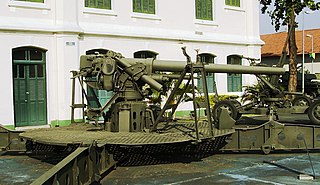 W
WThe 3-inch anti-aircraft gun M3 was an anti-aircraft gun which served throughout the 1930s and possibly into early World War II. Developed from the earlier 3-inch M1917 and 3-inch M1918 guns, it was in the process of being replaced by the time of the US entry into World War II, but was subsequently adapted into an anti-tank gun role, both free-standing and in a self-propelled tank destroyer.
 W
WThe 3.7 cm Flak 43 was a light anti-aircraft (AA) gun used by Nazi Germany during World War II. It was derived from the 3.7-centimeter (1.5 in) Flak 18/36/37 series of AA guns. It was provided with single- and twin-gun mounts, the latter being designated as the 3.7 cm Flak 43 Zwilling and was in service from 1944 to 1945. In addition to versions used by the Kriegsmarine, it served as the main armament of the Ostwind and Möbelwagen and was proposed for use in the Flakpanzer Coelian self-propelled AA guns.
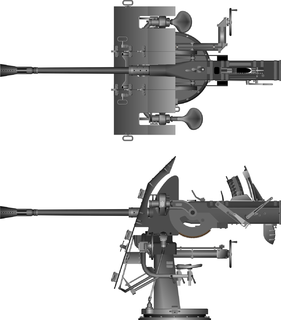 W
WThe 3.7 cm Flak M42 was the marine version of the 3.7-centimetre (1.5 in) Flak 36/37 and used by the Kriegsmarine on surface ships and as the M42U on Type VII and Type IX U-boats. The 3.7 cm Flak M42U used several types of mounts and entered service in autumn 1943.
 W
WThe 5 cm FlaK 41 (Flugabwehrkanone 41) was a German 50 mm (2.0 in) anti-aircraft gun produced for defending the intermediate zone above the range of light guns, but below the ceiling of the heavy pieces. The gun proved inadequate and was produced only in small numbers.
 W
W7,62 ITKK 31 VKT or 7,62 mm VKT anti-aircraft machine gun was the primary anti-aircraft machine gun of the Finnish Army during World War II. The weapon was designed by the Finnish gunsmith Aimo Lahti. 507 weapons were produced in two versions, 7,62 ItKk/31 VKT and an improved 7,62 ItKk/31-40 VKT, between 1933 and 1944.
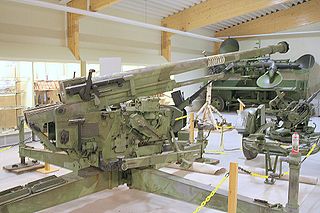 W
WThe 7.5 cm kanon PL vz. 37 was a Czech anti-aircraft gun used in World War II. Those weapons captured after the German occupation of Czechoslovakia in March 1939 were taken into Wehrmacht service as the 7.5 cm Flak M 37(t) or Flak Skoda. The Germans sold many of them to Italy where they were designated as the Cannone da 75/49 or 75/50. Surviving guns were taken back into German service after Italy's surrender in 1943. Twenty were sold to the Finns in November 1940. Twelve were in Luftwaffe service between April and September 1944.
 W
WThe 8 cm kanon PL vz. 37 (Anti-aircraft Gun Model 37 was a Czech anti-aircraft gun used during the Second World War. Those weapons captured after the German occupation of Czechoslovakia in March 1939 were taken into Wehrmacht service as the 7.65 cm Flak M 37 . 97 were in service during the Munich Crisis in September 1938 of which Slovakia seized one when it declared independence six months later.
 W
WThe 8.35 cm PL kanon vz. 22 was a Czech anti-aircraft gun used during World War II. Those weapons captured after the German occupation of Czechoslovakia in March 1939 were taken into Wehrmacht service as the 8.35 cm Flak 22(t). Some guns were reportedly captured in Yugoslavia as well. 144 were in Czech service during the Munich Crisis in September 1938 of which Slovakia seized between twenty-five and twenty-nine when it declared independence six months later. One hundred seven were in German service in August 1943, declining to twenty by October 1944.
 W
WThe 10.5 cm FlaK 38 was a German anti-aircraft gun used during World War II by the Luftwaffe. An improved version was introduced as the 10.5 cm FlaK 39.
 W
WThe 12.8 cm FlaK 40 was a German World War II anti-aircraft gun. Although it was not produced in great numbers, it was reportedly one of the most effective heavy AA guns of its era.
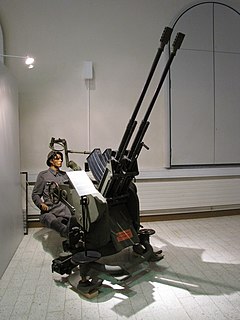 W
WThe 20 ItK 40 VKT or 20 mm dual anti-aircraft cannon model 1940 manufactured by VKT was a Finnish light anti-aircraft gun designed by the Finnish gunsmith Aimo Lahti. As the only multi-barrel 20 mm anti-aircraft gun 20 ItK 40 VKT was the most effective 20 mm air defence weapon used by the Finnish Army during World War II. A total of 174 guns were built, used in training until the 1970s and kept in reserve until 1988. The gun received the nickname Vekotin (gadget) from Finnish soldiers. The nickname was reached by adding to the abbreviation of manufacturer, VKT.
 W
WThe Polsten was a Polish development of the 20 mm Oerlikon gun. The Polsten was designed to be simpler and much cheaper to build than the Oerlikon, without reducing effectiveness.
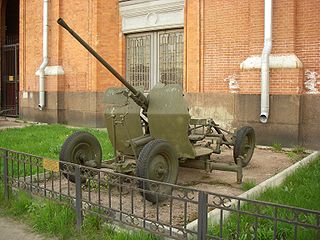 W
W25 mm automatic air defense gun M1940 (72-K) was a Soviet 25 mm caliber anti-aircraft gun used during the Great Patriotic War. The gun was developed from the end of 1939 to the beginning of 1940 at 8th Kalinin Artillery Plant under the guidance of its Chief Designer Mikhail Loginov, supervised by Lev Loktev. The cannon was given the factory code 72-K before being accepted into service by the Red Army as the 25 mm automatic air defense gun M1940.
 W
WThe Hotchkiss 25 mm anti-aircraft gun was an anti-aircraft autocannon designed by the French firm of Hotchkiss. It served in World War II with French, Japanese and other nations' forces. Other than the designer company and the calibre, this weapon is not related to the semi-automatic 25 mm Hotchkiss anti-tank gun; in particular, the cartridge used is different.
 W
WThe 37 mm automatic air defense gun M1939 (61-K) is a Soviet 37 mm calibre anti-aircraft gun developed during the late 1930s and used during World War II. The land-based version was replaced in Soviet service by the AZP S-60 during the 1950s. Guns of this type were successfully used throughout the Eastern Front against dive bombers and other low- and medium-altitude targets. It also had some usefulness against lightly armoured ground targets. Crews of the 37 mm AD guns shot down 14,657 Axis planes. The mean quantity of 37 mm ammunition to shoot down one enemy plane was 905 rounds.
 W
WThe 37 mm gun M1 was an anti-aircraft autocannon developed in the United States. It was used by the US Army in World War II.
 W
WThe 45 mm anti-aircraft gun (21-K) was a Soviet design adapted from the 45 mm anti-tank gun M1932 (19-K). This was a copy of a 3.7 cm (1.5 in) German weapon designed by Rheinmetall that was sold to the Soviets before Hitler came to power in 1933 that had been enlarged to 45 mm (1.8 in) to reuse a large stock of old 47mm ammunition. It was used by the Soviet Navy to equip almost all of their ships from 1934 as its primary light anti-aircraft gun until replaced by the fully automatic 37 mm 70-K gun from 1942 to 1943. It was used in World War II and during the Cold War as the Soviets exported their World War II-era ships to their friends and allies. However it was not very effective as its slow rate of fire and lack of a time fuze required a direct hit to damage targets.
 W
WThe 75 mm armata przeciwlotnicza wz.36 was a Polish designed and built anti-aircraft gun that was used during the Second World War.
 W
WThe 76 mm air defense gun M1931 was an anti-aircraft gun used by the Soviet Union during the Winter War and the first stages of World War II.
 W
WThe 85 mm air defense gun M1939 (52-K) was an 85 mm (3.3 in) Soviet anti-aircraft gun, developed under guidance of leading Soviet designers M. N. Loginov and G. D. Dorokhin. This gun was successfully used throughout the German-Soviet War against level bombers and other high- and medium-altitude targets. In emergencies they were utilized as powerful anti-tank weapons. The barrel of the 52-K was the basis for the family of 85-mm Soviet tank guns. After the war some 52-Ks were refitted for peaceful purposes as anti-avalanche guns in mountainous terrain.
 W
WThe 120 mm Gun M1 was the United States Army's standard super-heavy anti-aircraft gun during World War II and the Korean War, complementing the smaller and more mobile M2 90 mm gun in service. Its maximum altitude was about 60,000 ft (18,000 m), which earned it the nickname stratosphere gun.
 W
WThe AA mine discharger was a Japanese anti-aircraft weapon of the Second World War. The device was a simple tube like an infantry mortar of 70 mm or 81 mm caliber. Instead of a standard mortar bomb, the projectile was a tube containing seven individual mines, each approximately 11/16ths of an inch in diameter (18 mm) and 3 inches (76 mm) long. Each mine was equipped with its own parachute. When fired, the mortar threw the shell to a range of 3,000 to 4,000 feet and a maximum altitude of approximately 600 m. The shell ejected the mines at the top of its arc. They would then float down on their parachutes. They were fused to detonate on contact or after a fixed time period, damaging nearby aircraft. The projectile could alternatively be launched using a standard Type 11 70 mm infantry mortar.
 W
WThe Bofors 40 mm gun, often referred to simply as the Bofors gun, is an anti-aircraft autocannon designed in the 1930s by the Swedish arms manufacturer AB Bofors. It was one of the most popular medium-weight anti-aircraft systems during World War II, used by most of the western Allies as well as some captured systems being used by the Axis powers. A small number of these weapons remain in service to this day, and saw action as late as the Persian Gulf War.
 W
WBofors 75 mm and Bofors 80 mm were two closely related designs of anti-aircraft and general-purpose artillery. Less well known than the 40 mm quick-firing AA gun, the gun was nevertheless adopted by armed forces of numerous countries during World War II, including Argentina, China, Dutch East Indies, Finland, Greece, Hungary, Persia and Thailand. It was closely related to the 8.8 cm Flak 18/36/37/41, one of the best-known AA guns of World War II, which was partially based on it. Some pieces captured by the Japanese in China served as the blueprint for the Type 4 75 mm AA Gun, a reverse-engineered clone of the Bofors 75mm gun.
 W
WThe Cannone-Mitragliera da 20/65 modello 35 (Breda), also known as Breda Model 35, was a 20 mm anti-aircraft gun produced by the Società Italiana Ernesto Breda of Brescia company in Italy and used during World War II. It was designed in 1932 and was adopted by the Italian armed forces in 1935. It was the one of two 20-millimetre-calibre anti-aircraft guns used by Italy during World War II, the other being the 20 mm Scotti. Both weapons fired the 20x138mmB cartridge.
 W
WThe Canon de 75 contre avion modèle 1940 Schneider was a French 75 mm anti-aircraft gun designed and manufactured by Schneider et Cie at Le Creusot. These guns were used by the French Army during the Second World War.
 W
WThe Canon de 75 antiaérien mle 1913–1917 were a family of French 75 mm anti-aircraft guns designed and manufactured by Schneider et Cie at Le Creusot. The guns were used by the French Army during the First World War and Second World War.
 W
WThe Canon de 90 mm Modèle 1926 was a light-caliber dual-purpose gun used as primary armament on minesweeping sloops and anti-aircraft armament on a number of French Navy cruisers and battleships during World War II.
 W
WThe Gebirgsflak 38 was a German anti-aircraft weapon of World War II, a lightweight version of the 2 cm FlaK 38 designed for airborne and mountain troops as a dual purpose gun for use against air and ground targets. The main difference was that the carriage was smaller and lighter than the carriage for the FlaK 38. The gun and carriage were designed to allow the weapon to be broken into several pack loads for transport. The carriage has two wheels and when raised the gun has a 360° traverse. Unlike the Flak 38, the light carriage is not designed for high towing speeds.
 W
WThe 13.2 mm Hotchkiss machine gun was a heavy machine gun designed and manufactured by Hotchkiss et Cie from the late 1920s until World War II and saw service with various nations' forces, including Italy and Japan where the gun was built under license.
 W
WThe M45 Quadmount was a weapon mounting consisting of four of the "HB", or "heavy barrel" .50 caliber M2 Browning machine guns mounted in pairs on each side of an open, electrically powered turret. It was developed by the W. L. Maxson Corporation to replace the earlier M33 twin mount. Although designed as an anti-aircraft weapon, it was also used against ground targets. Introduced in 1943 during World War II, it remained in US service as late as the Vietnam War.
 W
WThe 20 mm AA Machine Cannon M/38 was a 20 mm rapid fire autocannon produced by the Danish company Dansk Industri Syndikat (DISA). The gun, which could be adapted to several tactical uses, was a primary weapon of the military of Denmark. It was also exported to numerous countries around the world because of its versatility. The cannon was built at the DISA works in Herlev near Copenhagen. The company supplied several different types of mountings with the weapon which allowed it to be employed in a variety roles such as aerial defences, anti-tank warfare or on naval ships.
 W
WThe Nkm wz.38 FK was a 20 mm heavy machine gun produced in inter-war Poland. It was used both in anti-air and anti-tank role and was also adapted for tank use and mounted on some TKS tankettes. Mass-produced in 1938 and 1939, it was used extensively during the September Campaign.
 W
WThe Oerlikon 20 mm cannon is a series of autocannons, based on an original German Becker Type M2 20 mm cannon design that appeared very early in World War I. It was widely produced by Oerlikon Contraves and others, with various models employed by both Allied and Axis forces during World War II, and many versions are still in use today.
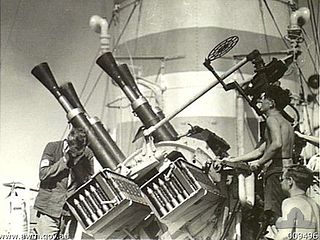 W
WThe 2-pounder gun, officially designated the QF 2-pounder and universally known as the pom-pom, was a 40-millimetre (1.6 in) British autocannon, used as an anti-aircraft gun by the Royal Navy. The name came from the sound that the original models make when firing. This QF 2-pounder was not the same gun as the Ordnance QF 2 pounder, used by the British Army as an anti-tank gun and a tank gun, although they both fired 2-pound (0.91 kg), 40-millimetre (1.6 in) projectiles.
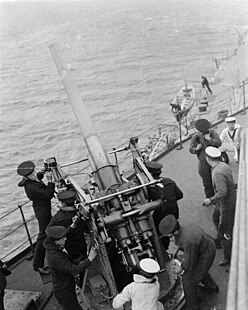 W
WThe QF 3 inch 20 cwt anti-aircraft gun became the standard anti-aircraft gun used in the home defence of the United Kingdom against German airships and bombers and on the Western Front in World War I. It was also common on British warships in World War I and submarines in World War II. 20 cwt referred to the weight of the barrel and breech, to differentiate it from other "3 inch" guns. While other AA guns also had a bore of 3 inches (76 mm), the term "3 inch" was only ever used to identify this gun in the World War I era, and hence this is what writers are usually referring to by "3 inch AA gun".
 W
WThe QF 3.7-inch AA was Britain's primary heavy anti-aircraft gun during World War II. It was roughly the equivalent of the German 88 mm FlaK and American 90 mm, but with a slightly larger calibre of 3.7 inches, approximately 94 mm. Production began in 1937 and it was used throughout World War II in all theatres except the Eastern Front. It remained in use after the war until AA guns were replaced by guided missiles beginning in 1957.
 W
WThe QF 4 inch Mk XVI gun was the standard British Commonwealth naval anti-aircraft and dual-purpose gun of World War II.
 W
WThe QF 4.5 inch gun has been the standard medium-calibre naval gun used by the Royal Navy as a medium-range weapon capable of use against surface, aircraft and shore bombardment targets since 1938. This article covers the early 45-calibre family of guns up to the 1970s. For the later unrelated 55-calibre Royal Navy gun, see 4.5 inch Mark 8 naval gun.
 W
WThe 4.7 inch QF Mark IX and Mark XII were 45-calibre, 4.7-inch (120 mm) naval guns which armed the majority of Royal Navy and Commonwealth destroyers in World War II, and were exported to many countries after World War II as the destroyers they were mounted on were sold off.
 W
WThe 4.7 inch QF Mark XI was a 50-calibre, 4.7-inch (120 mm) naval gun deployed on Royal Navy (RN) and Allied destroyers during World War II.
 W
WThe Solothurn ST-5 is a 20 mm anti-aircraft gun designed by Solothurn in Switzerland which ultimately was the design basis for the highly successful 2 cm FlaK 30 series of guns used by Germany in World War II.
 W
WThe Type 2 20 mm AA machine cannon was a Japanese-designed anti-aircraft gun, based on the German Flak 38. It entered service in 1942.
 W
WThe Type 3 12 cm AA gun was an anti-aircraft gun used in quantity by the Imperial Japanese Army during World War II.The Type 3 number was designated for the year the gun was accepted, 2603 in the Japanese imperial year calendar, or 1943 in the Gregorian calendar. It replaced the earlier Type 88 75 mm AA Gun in Japanese service.
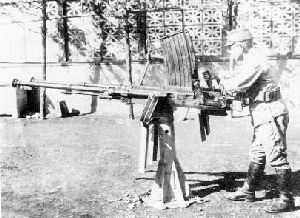 W
WType 4 20 mm twin AA machine cannon was an Imperial Japanese Army (IJA) anti-aircraft gun. It consisted of two Type 98 20 mm AA machine cannon. It was introduced in 1944 and approximately 500 guns were produced.
 W
WThe Type 4 75 mm AA gun was an anti-aircraft gun developed by the Imperial Japanese Army. They started producing the gun in 1943. The Type 4 number was designated for the year the gun was accepted, 2604 in the Japanese imperial year calendar, or 1944 in the Gregorian calendar. Due to the lack of raw materials available and the great damage by air raids to its industrial infrastructure, only 70 units were made. These units were retained for defense of the Japanese home islands during World War II.
 W
WThe Type 5 15 cm AA gun was a large caliber anti-aircraft gun developed by the Imperial Japanese Army during the final days of World War II. The Type 5 number was designated for the year the gun was accepted, 2605 in the Japanese imperial year calendar, or 1945 in the Gregorian calendar. It was intended to replace the earlier Type 3 12 cm AA Gun as a defense against American air raids.
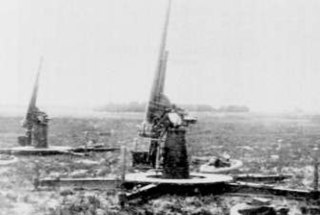 W
WThe Type 11 75 mm anti-aircraft gun was an anti-aircraft gun used by the Imperial Japanese Army after World War I. The Type 11 designation was given to this gun as it was accepted in the 11th year of Emperor Taishō's reign (1922). It was the first anti-aircraft gun in Japanese service, but only a small number were produced, and it was superseded by the Type 14 10 cm gun and the Type 88 75 mm gun in active service before the start of World War II.
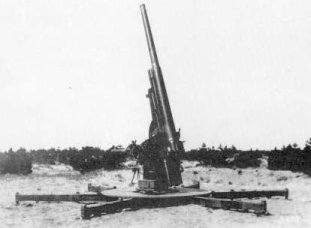 W
WThe Type 14 10 cm AA gun was an anti-aircraft gun used by the Imperial Japanese Army after World War I. The Type 14 number was designated for the year the gun was accepted, the 14th year of Emperor Taishō's reign, 1929 in the Gregorian calendar. Only a small number were produced, and it was superseded by the Type 88 75 mm AA gun in production before the start of World War II.
 W
WThe Type 88 75 mm AA gun was an anti-aircraft gun used by the Imperial Japanese Army during the Second Sino-Japanese War and World War II. The Type 88 number was designated for the year the gun was accepted, 2588 in the Japanese imperial year calendar, or 1928 in the Gregorian calendar. It replaced the earlier Type 11 75 mm AA gun in front line combat service, and at the time was equal in performances to any of its contemporaries in western armies and was considered capable of handling any targets the Japanese army was likely to encounter on the Asian mainland. Although it was soon overtaken by improvements in aircraft technology and was largely obsolete by 1941, it continued to be used on many fronts until the end of the war.
 W
WThe Type 98 20 mm AA machine cannon was the most common light anti-aircraft gun of the Imperial Japanese Army. It entered service in 1938 and was used until the end of World War II. After World War II this gun was used by the Indonesian Army in the Indonesian National Revolution and North Vietnam in First Indochina War.
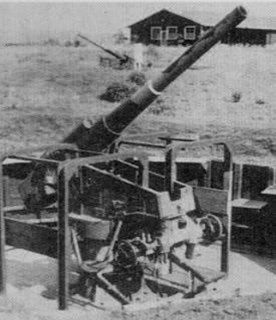 W
WThe Type 99 88 mm AA gun was an anti-aircraft gun used by the Imperial Japanese Army during World War II. The Type 99's number was designated for the year the gun was accepted, 2599 in the Japanese imperial year calendar.
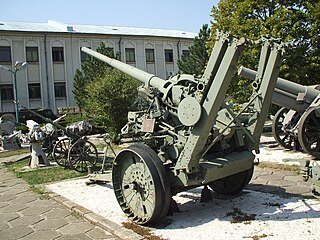 W
WThe Vickers Model 1931 was a British anti-aircraft gun used during the Second World War. The design was rejected by the British and Vickers exported the gun worldwide during the 1930s. Romania bought a license for 100 in 1936, although hundreds more were built during the war. The second batch of 100 pieces was started in July 1941, the production rate being of 5 pieces per month as of October 1942. Denmark also bought a license. Belgium, the Netherlands, Lithuania, Turkey, Switzerland and China bought numbers of guns directly from Vickers. Finland bought a dozen to help reduce balance of payment problems with the British in 1936. The Finnish guns were chambered in their standard 76.2 mm (3 in) caliber. Those weapons captured after the German conquest of Europe were taken into Wehrmacht service as the 7.5 cm Flak M 35(h) or 7.5 cm Flak M 35(d). Similarly the Soviet Union used those guns it captured from Lithuania. Supposedly it saw limited British service with Home Defense "barrage units" 1940—43.